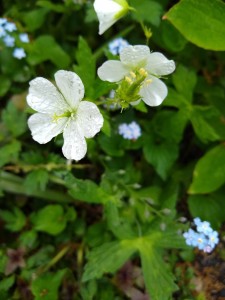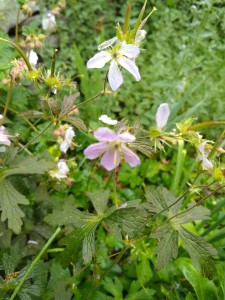 Romantic poet William Wordsworth was fond of rambling through the English countryside, often accompanied by his devoted sister, Dorothy. Waxing sentimental about flowers, plants and nature was almost a requirement for Romantic poets, and Wordsworth did so frequently. I especially like his description of a meadow flower:
Romantic poet William Wordsworth was fond of rambling through the English countryside, often accompanied by his devoted sister, Dorothy. Waxing sentimental about flowers, plants and nature was almost a requirement for Romantic poets, and Wordsworth did so frequently. I especially like his description of a meadow flower:
How does the Meadow flower its bloom unfold?
Because the lovely little flower is free down to its root,
and in that freedom bold.
I don’t generally think of Wordsworth when I am spreading mulch and digging up crabgrass, but lately I have been doing a lot of thinking about meadow cranesbill or Geranium pratense. It is an extremely likable and useful hardy geranium species, which in turn is part of the large Geraniaceae family. As is often the case with plants, taxonomy creates confusion for the hardy geranium. What most of us call “geranium” is actually a pelargonium as far as plant taxonomists are concerned. You can clarify the matter by continuing to refer to the big-headed flowering plant in your window box or container array, as a “geranium”. If you buy a meadow cranesbill or any other type of perennial geranium, call it a “hardy geranium”. Most plant people, nursery personnel and gardeners will know what you are talking about.
If you look at one of the individual flowers in a large pelargonium flowerhead, you will see that it is really a simple thing with just five petals. This five-pedaled configuration is also characteristic of cranesbills, unless they are double-flowered. Meadow cranesbill and its hardy geranium relatives generally carry their flowers singly or in very loose clusters at the tops of the stems. When the petals drop, the resulting seed capsules bears a resemblance to a crane’s head
and bill, giving rise to the common and Latin genus names. When those capsules ripen and burst open, they can spit seeds several feet from the parent plant, spreading the geranium wealth very neatly.
What makes meadow cranesbill worthy of Wordsworthian inspiration? Beautiful flowers and foliage, for starters. The flowers, which rise above the leaves and generally bloom most abundantly in mid to late spring. They appear most often in shades of blue-purple , but advances in breeding have resulted in flowers that may appear in shades of white, pink or pink-purple. Some varieties also feature contrasting veins that stripe each petal.
 Foliage matters a lot to gardeners who crave plants that pull their aesthetic weight throughout the gardening season. Meadow cranesbills do not disappoint in that department. The leaves are almost fern like, divided into deeply dissected lobes. The plants have a spreading, somewhat mounding habit, so those lovely leaves are on full display on specimens that can grow two to three feet tall and wide. Most often the foliage is medium to dark green, but some varieties feature chocolate brown to deep purple-black leaves.
Foliage matters a lot to gardeners who crave plants that pull their aesthetic weight throughout the gardening season. Meadow cranesbills do not disappoint in that department. The leaves are almost fern like, divided into deeply dissected lobes. The plants have a spreading, somewhat mounding habit, so those lovely leaves are on full display on specimens that can grow two to three feet tall and wide. Most often the foliage is medium to dark green, but some varieties feature chocolate brown to deep purple-black leaves.
Meadow cranesbills did not start out in North American meadows. The ancestors of today’s plants came from areas of northern Europe and Asia. Once they arrived here, they enchanted gardeners and demonstrated their hardiness and adaptability by escaping from gardens and naturalizing in some places. Despite those tendencies, they are not considered invasive.
The Geraniaceae specialist nursery carries no less than 23 varieties of Geranium pretense. I am very partial to the ones with dark leaves, like ‘Midnight Reiter’, which features dark maroon foliage and flowers that approach true blue with only a bit of purple. Another beauty, ‘Mrs. Kendall Clark’ journeyed here from England bearing blue gray flowers and dark green leaves. Lovers of double-flowered varieties, like me, can rejoice in ‘Plenum Violaceum’, with flowers that resemble blue-purple rosebuds; and ‘Double Jewel’ , with white blooms veined in purple. I find that the white, single-flowered varieties like Geranium pratense f. albiflorum or ‘Galactic’ lighten things up in the spring garden, blooming along with the first irises and the last forget-me-nots.
Meadow cranesbills are good garden companions, getting along in the front or middle of beds and borders. They flourish in sun or light shade and prefer consistent moisture, especially as new plants establish themselves. Butterflies like cranesbills, but varmints generally don’t.
Every garden center seems to carry at least some hardy geraniums and many of them are quite beautiful. Meadow cranesbill is a little harder to find. For the best selection go to California-based online vendor Geraniaceae, (415) 461-4168; www.geraniaceae.com.
